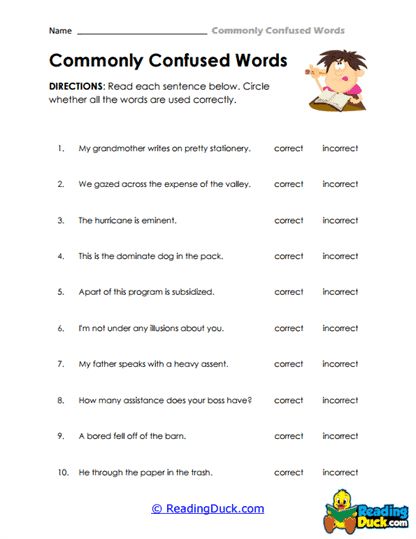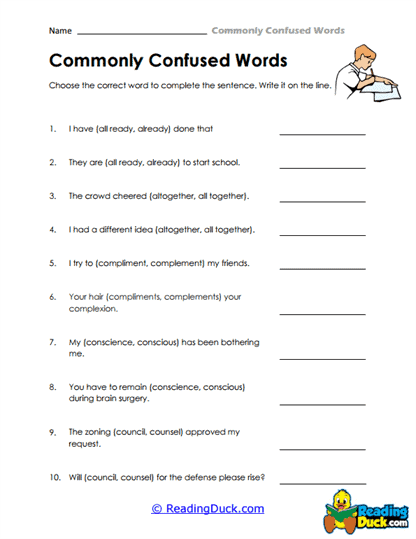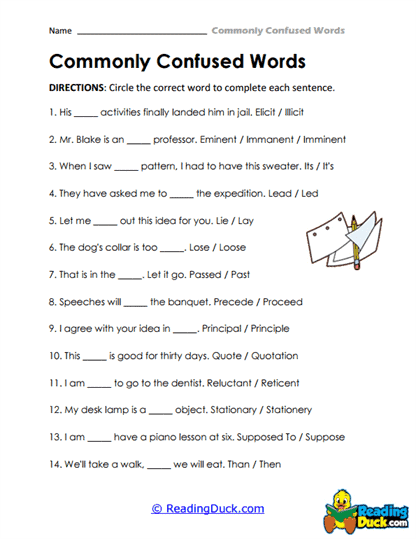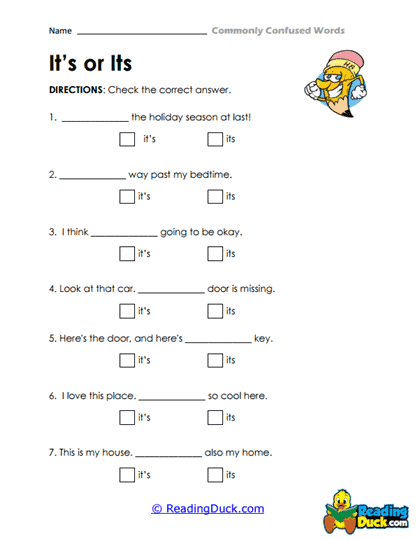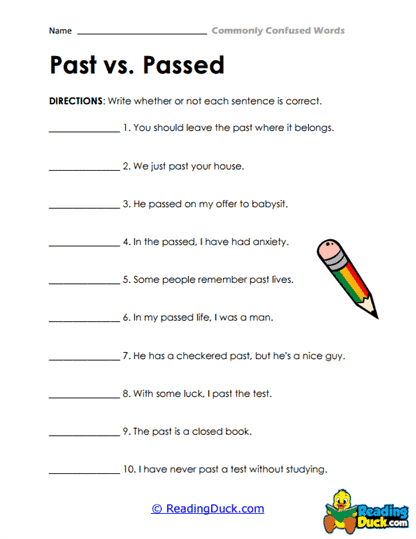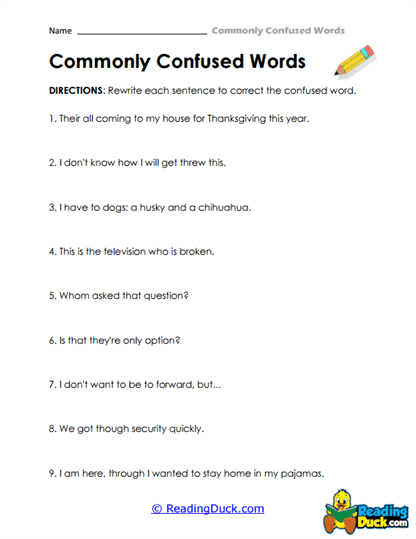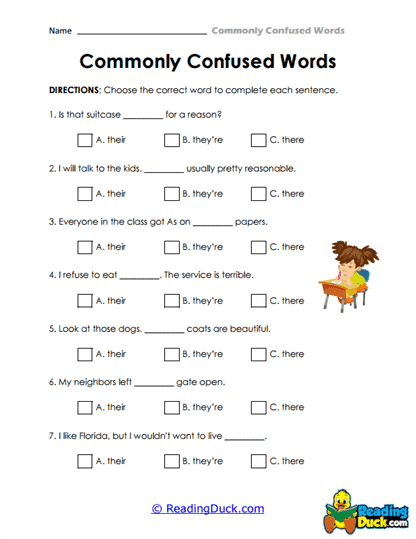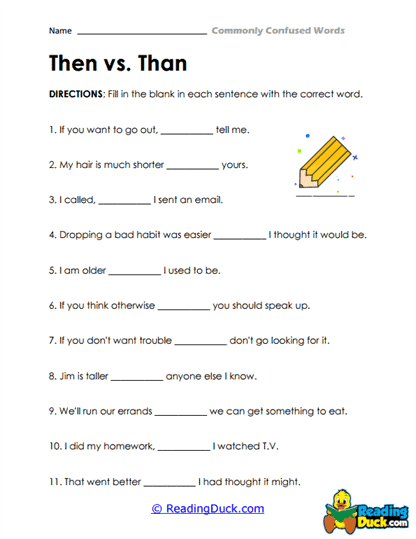Commonly Confused Words Worksheets
About Our Commonly Confused Words Worksheets
Our collection of Commonly Confused Words Worksheets is designed to help students master the tricky vocabulary that can cause errors in both written and spoken language. These worksheets focus on words that sound similar, look alike, or are otherwise easy to mix up but have different meanings and uses. Proper understanding and usage of these words are essential for students to communicate clearly and effectively, both academically and in everyday situations.
These worksheets are available in PDF format, making them easy to view, download, and print. Each worksheet also includes a downloadable answer key for quick grading and review, making it simple for educators and parents to assess progress. Learning how to distinguish between commonly confused words is a critical step in building a strong foundation in vocabulary and language comprehension.
Understanding Commonly Confused Words: An Introduction
Commonly confused words are words that often get mixed up because they may sound alike (homophones), look similar, or have meanings that are easily confused. Some classic examples include:
- Their, there, they’re
- Your, you’re
- To, too, two
- Affect, effect
Teaching students to distinguish between these words is crucial for improving their writing and speaking accuracy. Many of these words share similar sounds but have very different meanings, which can lead to misunderstandings if used incorrectly. For example:
- Their refers to possession ("Their house is on the corner"), while there refers to a location ("The book is over there").
- Affect is a verb meaning to influence something ("The weather affects my mood"), while effect is a noun that describes the result of a change ("The effect of the new rule was positive").
When explaining commonly confused words, it's important to break down the distinctions clearly and provide relatable examples that students can remember:
- Homophones: Words that sound the same but have different spellings and meanings, like flower (a plant) and flour (used in baking).
- Homonyms: Words that are spelled and pronounced the same but have different meanings, such as bat (an animal) and bat (a piece of sports equipment).
- Words with similar meanings: Words like affect and effect or imply and infer that are related but used in different grammatical contexts.
By addressing these distinctions early on, students can avoid common pitfalls in their writing and communication. Through the use of Commonly Confused Words Worksheets, students can practice identifying, understanding, and using these words correctly in context, leading to clearer and more accurate communication.
Strengthening Vocabulary Skills
One of the key benefits of mastering commonly confused words is the improvement of overall vocabulary skills. These worksheets are designed to help students understand the nuances between similar words, making them more precise in their language use. Some of the vocabulary-building advantages of learning commonly confused words include:
- Clarity in Communication: When students know how to correctly use words like accept and except, they can express themselves more clearly. For instance, "I will accept the award" has a completely different meaning than "I will except the award."
- Enhanced Writing Quality: Understanding the differences between commonly confused words can significantly elevate the quality of students' writing. For example, knowing when to use compliment (to praise) versus complement (to complete) can make writing more accurate and polished.
- Increased Confidence in Word Choice: As students become more familiar with commonly confused words, they gain confidence in selecting the right word for the right context. This helps eliminate hesitation and errors in both spoken and written language.
Additionally, these worksheets encourage students to:
- Recognize patterns in word usage, which helps them differentiate between words that may sound or look similar but have different meanings.
- Practice critical thinking by analyzing the context in which these words are used, reinforcing their understanding of proper word choice in sentences and paragraphs.
Mastering these distinctions builds a stronger vocabulary foundation, allowing students to tackle more complex language tasks with ease and accuracy.
Flexible Use for a Range of Learning Settings
Our Commonly Confused Words Worksheets are designed for flexible use, catering to various educational environments and learning needs. Whether used in the classroom, assigned as homework, or utilized for independent study, these worksheets provide an accessible and convenient resource for vocabulary development.
- Classroom Instruction: Teachers can incorporate the worksheets into daily lessons to reinforce grammar and vocabulary skills. They are particularly effective as part of language arts lessons or in preparation for writing assignments.
- Homework Assignments: The worksheets can be easily assigned as homework, giving students the opportunity to practice and refine their understanding of commonly confused words at their own pace.
- Independent Study: Students preparing for standardized tests or seeking to improve their writing on their own can use the worksheets for self-study. The PDF format makes it simple to download and print the materials for use outside the classroom.
Each worksheet is accompanied by an answer key, allowing teachers and parents to quickly assess students' progress and provide targeted feedback. This ease of use makes the worksheets a valuable resource for supporting consistent language practice, no matter the setting.
Real-World Applications of Mastering Commonly Confused Words
Understanding and correctly using commonly confused words has a wide range of real-world applications. These vocabulary skills are essential not only for academic success but also for clear communication in everyday life. Whether students are writing essays, sending emails, or engaging in conversations, knowing how to distinguish between similar words helps them avoid misunderstandings and express themselves more effectively.
Some practical applications of mastering commonly confused words include:
- Professional Communication: In the workplace, the ability to use precise language can make a significant difference in how clearly ideas are conveyed. Mistakes involving words like stationary (not moving) and stationery (writing materials) or principal (head of a school) and principle (a fundamental belief) can lead to confusion and misinterpretation.
- Social Media and Texting: Even in casual writing, such as on social media or in text messages, using the correct word enhances the clarity of the message. Knowing the difference between lose (to misplace) and loose (not tight) is critical for conveying the right meaning.
- Creative Writing: In literary contexts, the choice between similar words can significantly affect the tone and meaning of a piece. For example, an author might choose allusion (an indirect reference) versus illusion (a deceptive appearance) based on the message they wish to convey.
In addition to these everyday benefits, mastering commonly confused words is also crucial for academic achievement. Many standardized tests, including the SAT, ACT, and TOEFL, include questions that assess a student's ability to distinguish between words with similar sounds or meanings. By practicing with our Commonly Confused Words Worksheets, students will be better prepared to navigate these vocabulary questions with confidence and accuracy.
Preparing for Success in Standardized Tests
Commonly confused words often appear in the vocabulary sections of major standardized tests, making it essential for students to master these distinctions. These worksheets provide valuable practice that can help students:
- Identify the correct word in context: Standardized tests frequently ask students to select the appropriate word based on the surrounding sentence or passage. Practicing with commonly confused words sharpens this skill.
- Enhance grammar and language understanding: Many test questions require students to demonstrate their grasp of word usage, grammar, and sentence structure. Mastery of commonly confused words contributes to a stronger overall understanding of the English language.
- Improve reading comprehension: Understanding commonly confused words also helps students better comprehend reading passages in tests, as these words are often used in subtle ways to assess reading skills.
By practicing regularly with these worksheets, students will be well-equipped to handle the challenging vocabulary sections of exams like the SAT, ACT, and TOEFL, improving their chances of success.
Building Strong Communication Skills with Commonly Confused Words
Our Commonly Confused Words Worksheets provide a comprehensive and effective way for students to improve their vocabulary, enhance language comprehension, and build strong communication skills. Available in PDF format for easy download and printing, these worksheets are designed for use in a wide range of learning environments, from classrooms to independent study.
By mastering the distinctions between commonly confused words, students will gain the ability to write and speak with greater clarity and precision, which is crucial for academic success and real-world communication. These skills also play a key role in preparing students for standardized tests and future professional writing tasks, helping them express their ideas accurately and confidently.
Through consistent practice with these worksheets, students will build a solid foundation in vocabulary that will serve them well throughout their educational journey and beyond.

